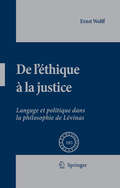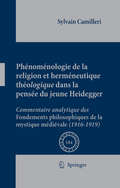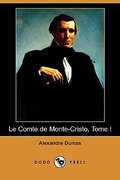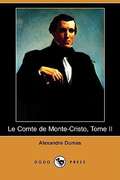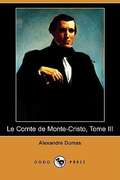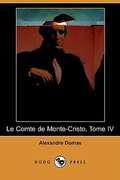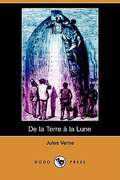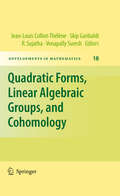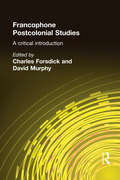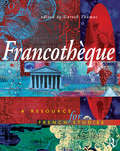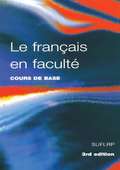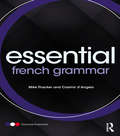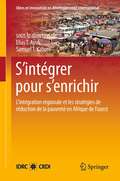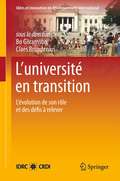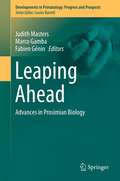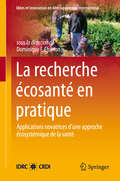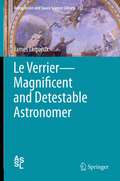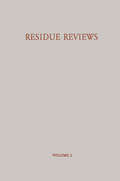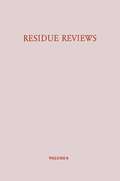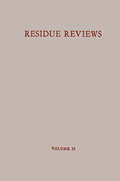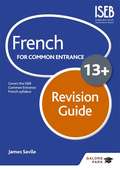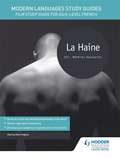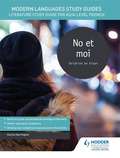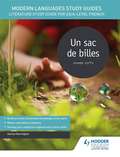- Table View
- List View
Rediscovering Phenomenology: Phenomenological Essays on Mathematical Beings, Physical Reality, Perception and Consciousness (Phaenomenologica #182)
by Luciano Boi Pierre Kerszberg Édéric PatrasThis book proposes a new phenomenological analysis of the questions of perception and cognition which are of paramount importance for a better understanding of those processes which underlies the formation of knowledge and consciousness. It presents many clear arguments showing how a phenomenological perspective helps to deeply interpret most fundamental findings of current research in neurosciences and also in mathematical and physical sciences.
De L'éthique à la Justice: Langage et politique dans la philosophie de Lévinas (Phaenomenologica #183)
by Ernst WolffEmmanuel Lévinas est le philosophe de la non-indifférence; il n’est en aucune sorte un philosophe indifférent. Son inquiétude personnelle et engagement politique ont trouvé une expression philosophique dans une quête à deux versants. Dans le versant ontologique, il cherche à montrer que même si l’homme est l’événement de compréhension de l’être, tout l’homme et toute signification ne se réduisent pas à la compréhension de l’être seul. Dans le versant politique, il s’interroge sur la possibilité de soumettre la tendance totalitaire de toute politique à une recherche de justice qui ne dépend pas finalement de la politique même. Mais ces deux versants n’en font qu’un. La découverte d’une signification qui excède la compréhension de l’être – l’éthique – fournit en même temps la source de renouvellement de la justice. Ainsi, par cette double question, Lévinas nous présente les fils conducteurs de notre enquête: une signification au-delà de la compréhension de l’être et sa portée éthique, que nous appelons «langage» et que nous explorons dans la perspective de son importance politique. Les études analytiques dans lesquelles les notions de politique et de langage fonctionnent comme clef d’interprétation mutuelle débouchent sur une critique centrée sur deux problèmes: l’impossibilité d’interpréter la signifiance de l’autre et le danger inhérent à la conception d’une justice dépassant l’Etat.
Phénoménologie de la religion et herméneutique théologique dans la pensée du jeune Heidegger: Commentaire analytique des Fondements philosophiques de la mystique médiévale (1916-1919) (Phaenomenologica #184)
by Sylvain CamilleriCette étude tente de reconstruire la première phénoménologie de la religion du jeune Heidegger par l’examen du recueil de notes éparses rédigées entre 1916 et 1919 et intitulé rétrospectivement Les fondements philosophiques de la mystique médiévale. Entre sa thèse d’habilitation et ses premiers cours d’après-guerre, Heidegger se consacre à l’écriture d’une Phénoménologie de la conscience religieuse qui, pour des raisons quelque peu mystérieuses, restera finalement inachevée. Si certains de ses éléments seront repris et assimilés dans les cours sur Paul et Augustin des années 1920 et 1921, de nombreux autres, concernant des auteurs tels que Maître Eckhart, Bernard de Clairvaux, Luther, Schleiermacher ou Adolf Reinach, ou des notions phénoménologiques, théologiques et religieuses, telles que la prédonation, la foi, la prière ou l’a priori religieux, trouvent dans ce texte une thématisation tout à fait spécifique, dictée par une situation biographique et philosophique singulière. C’est pour répondre à cette dimension hapaxique que ce livre tente un commentaire exhaustif des notes heideggeriennes. Et c’est à l’occasion de cette lecture suivie que sont apparues les grandes lignes de ce que l’on peut appeler une « herméneutique théologique » censée guider la phénoménologie sur le terrain religieux nouvellement investi et la familiariser avec des phénomènes qui résistent en certains endroits à son esprit méthodique. Malgré leur caractère introductif, les premières recherches de Heidegger témoignent d’une richesse, d’une profondeur et d’un respect de la vie religieuse inégalés à ce jour et il n’est pas exagéré de dire qu’elles devraient servir de prolégomènes à toute phénoménologie future de la religion. Ainsi, parallèlement au travail d’explication, le travail ici présenté esquisse en ce domaine quelques chemins possibles en prolongeant certaines descriptions heideggeriennes et en posant les bases d’un nouveau dialogue entre phénoménologie, théologie et sciences religieuses.
Le comte de Monte-Cristo, Tome I
by Alexandre DumasAlexandre Dumas (1802-1870) est un crivain franais. Il est n Villers-Cotterts (Aisne). Il reut une ducation plutt mediocre. Aprs des tudes ngliges, il travailla comme clerc chez un notaire et dbuta la rdaction de pices de th[tre avec son ami, le vicomte Adolphe Ribbing de Leuven. Ces premiers essais furent autant dchecs. En 1823, il entra au service du Duc dOrlans comme expditionnaire gr[ce sa calligraphie. Il lisait alors Shakespeare, Walter Scott, Goethe et Schiller qui furent les sources dinspiration principales de son th[tre. Il continua crire pour le th[tre et connut enfin le succs gr[ce la reprsentation en 1829 de Henri III et sa cour par la Comdie-Franaise. Ce succs continua pendant toute sa carrire littraire dans ses genres de prdilection: le drame, le roman historique et le feuilleton. Ses oeuvres comprennent: Les Trois Mousquetaires (1844), Le Comte de Monte-Cristo (1845-1846) et Le Vicomte de Bragelonne (1848).
Le comte de Monte-Cristo, Tome II
by Alexandre DumasAlexandre Dumas (1802-1870) est un crivain franais. Il est n Villers-Cotterts (Aisne). Il reut une ducation plutt mediocre. Aprs des tudes ngliges, il travailla comme clerc chez un notaire et dbuta la rdaction de pices de th[tre avec son ami, le vicomte Adolphe Ribbing de Leuven. Ces premiers essais furent autant dchecs. En 1823, il entra au service du Duc dOrlans comme expditionnaire gr[ce sa calligraphie. Il lisait alors Shakespeare, Walter Scott, Goethe et Schiller qui furent les sources dinspiration principales de son th[tre. Il continua crire pour le th[tre et connut enfin le succs gr[ce la reprsentation en 1829 de Henri III et sa cour par la Comdie-Franaise. Ce succs continua pendant toute sa carrire littraire dans ses genres de prdilection: le drame, le roman historique et le feuilleton. Ses oeuvres comprennent: Les Trois Mousquetaires (1844), Le Comte de Monte-Cristo (1845-1846) et Le Vicomte de Bragelonne (1848).
Le comte de Monte-Cristo, Tome III
by Alexandre DumasAlexandre Dumas (1802-1870) est un crivain franais. Il est n Villers-Cotterts (Aisne). Il reut une ducation plutt mediocre. Aprs des tudes ngliges, il travailla comme clerc chez un notaire et dbuta la rdaction de pices de th[tre avec son ami, le vicomte Adolphe Ribbing de Leuven. Ces premiers essais furent autant dchecs. En 1823, il entra au service du Duc dOrlans comme expditionnaire gr[ce sa calligraphie. Il lisait alors Shakespeare, Walter Scott, Goethe et Schiller qui furent les sources dinspiration principales de son th[tre. Il continua crire pour le th[tre et connut enfin le succs gr[ce la reprsentation en 1829 de Henri III et sa cour par la Comdie-Franaise. Ce succs continua pendant toute sa carrire littraire dans ses genres de prdilection: le drame, le roman historique et le feuilleton. Ses oeuvres comprennent: Les Trois Mousquetaires (1844), Le Comte de Monte-Cristo (1845-1846) et Le Vicomte de Bragelonne (1848).
Le comte de Monte-Cristo, Tome IV
by Alexandre DumasAlexandre Dumas (1802-1870) est un crivain franais. Il est n Villers-Cotterts (Aisne). Il reut une ducation plutt mediocre. Aprs des tudes ngliges, il travailla comme clerc chez un notaire et dbuta la rdaction de pices de th[tre avec son ami, le vicomte Adolphe Ribbing de Leuven. Ces premiers essais furent autant dchecs. En 1823, il entra au service du Duc dOrlans comme expditionnaire gr[ce sa calligraphie. Il lisait alors Shakespeare, Walter Scott, Goethe et Schiller qui furent les sources dinspiration principales de son th[tre. Il continua crire pour le th[tre et connut enfin le succs gr[ce la reprsentation en 1829 de Henri III et sa cour par la Comdie-Franaise. Ce succs continua pendant toute sa carrire littraire dans ses genres de prdilection: le drame, le roman historique et le feuilleton. Ses oeuvres comprennent: Les Trois Mousquetaires (1844), Le Comte de Monte-Cristo (1845-1846) et Le Vicomte de Bragelonne (1848).
De la Terre à la Lune
by Jules VerneIt tells the story of the Baltimore Gun Club, a post-American Civil War society of weapons enthusiasts, and their attempts to build an enormous sky-facing Columbiad space gun and launch three people—the Gun Club's president, his Philadelphian armor-making rival, and a French poet—in a projectile with the goal of a moon landing.
Quadratic Forms, Linear Algebraic Groups, and Cohomology (Developments in Mathematics #18)
by Skip Garibaldi R. Sujatha Venapally SureshFrancophone Postcolonial Studies: A critical introduction
by Charles Forsdick David MurphyThis landmark text constitutes the first comprehensive overview of Francophone Postcolonial Studies. Moving away from reductive geographical or linguistic surveys of the Francophone world, this collection of original essays provides a thematic discussion of the complex historical, political and cultural links between France and its former colonies. Providing a theoretical framework for postcolonial criticism of the field, it also aims to trigger a genuine dialogue between Francophone and Anglophone scholars of postcolonialism.Part I provides a historical overview, from the eighteenth to the twentieth century, addressing issues of colonialism, slavery and exoticism. Part II looks at language issues and discusses France's belief in the universality of its language and culture and the postcolonial challenges to that view. Part III discusses issues of diversity and multiculturalism in contemporary Francophone cultures. Part IV concludes with an analysis of the French-language contribution to postcolonialism as well as an examination of Francophone postcolonial thought and culture in the principal areas of the French-speaking world.Edited by two of the up-and-coming names in Francophone Postcolonial Studies, the collection includes contributions from an international team including some of the world's leading scholars in the field.
Francotheque: A resource for French studies
by Open University Open University"Francotheque" seeks to provide a French-language resource for undergraduate students of French. Direct access to contemporary French culture and society is offered through carefully selected authentic texts and a comprehensive overview of France and the French is provided under six broad headings - history, multicultural society, media, the arts, science and technology, the Francophone world - through press articles, historical documents, photographs, posters, advertisements, statistics, poems and songs. Each section starts with an introduction. The authentic texts are accompanied by vocabulary notes, and where appropriate, explanations filling in cultural background. One of the features of the book is the "sujets de reflexion", which provide pre-reading stimulus, thus suggesting a particular context of focus from which to approach many of the contexts.
Le Francais en Faculte
by Robin Adamson Geoff Hare James Coleman Margaret Lang Anthony Lodge Richard WakelySubstantially revised and updated, this is the third edition of a highly popular book which has been helping students for decades. It provides a sound base of linguistic competence upon which students can build with confidence. Comprises twelve thematic modules each including a relevant and contemporary text based on an aspect of French life and culture, associated exercises, and a section on grammar.
Essential French Grammar
by Mike Thacker Casimir D'AngeloEssential French Grammar is an innovative reference grammar and workbook for intermediate and advanced undergraduate students of French (CEFR levels B2 to C1). Its clear explanations of grammar are supported by contemporary examples and lively cartoon drawings. Each chapter contains:* real-life language examples in French, with English translations* a 'key points' box and tables that summarise grammar concepts* a variety of exercises to reinforce learning* a contemporary primary source or literary extract to illustrate grammar in context.To aid your understanding, this book also contains a glossary of grammatical terms in French and English, useful verb tables and a key to the exercises.Together, these features all help you to grasp complex points of grammar and develop your French language skills.
S’intégrer pour s’enrichir: L’intégration régionale et les stratégies de réduction de la pauvreté en Afrique de l’ouest (Idées et innovation en développement international)
by Elias T. Ayuk and Samuel T. KaboréL’intégration régionale comme premier pas vers l’accès au marché mondial? Dans un contexte où la libéralisation du commerce n'a pas entraîné les gains escomptés par les pays sous-développés et où la croissance du commerce mondial ne s’est pas accompagnée d’une croissance économique équivalente, une solution alternative a émergée. Un nouveau paradigme a fait valoir que la libéralisation des échanges devait s’accompagner d’investissements publics. Cela dit, la nature même de la libéralisation du commerce entraîne une diminution des ressources nécessaires aux investissements publics. Sur la base d’arguments solides, les pays sous-développés sont donc actuellement encouragés à mettre d’abord l’accent sur l'intégration régionale avant de rechercher l’accès au marché mondial. Cet ouvrage, qui aborde les questions liées à l’intégration régionale en Afrique de l’ouest, présente des données empiriques sur les efforts entrepris par les pays de l'Union économique et monétaire ouest-africaine (UEMOA) pour la convergence de leurs économies. Il examine également comment ces efforts, qui représentent un élément important pour l’intégration régionale, influent sur la réduction de la pauvreté dans les pays de l’UEMOA. Il intéressera par conséquent tous les chercheurs qui travaillent sur ce thème.
L’université en transition: L’évolution de son rôle et des défis à relever (Idées et innovation en développement international)
by Bo Göransson and Claes BrundeniusLa mondialisation, l’ère de l’information et l’essor de l’économie du savoir transforment profondément les modalités d’acquisition, de diffusion et de transformation du savoir. Il s’ensuit que la production du savoir a graduellement davantage à voir avec la compétitivité économique et y est plus directement liée. Ce nouvel état de fait signifie également que les universités se sentent de plus en plus poussées à s’adapter aux besoins de la société et de l’économie, qui évoluent sans cesse. En particulier, des pressions croissantes s’exercent sur les établissements d’enseignement supérieur et de recherche des pays industrialisés pour qu’ils définissent et affirment leur nouveau rôle au sein du système national d’innovation. Les établissements des pays en développement, quant à eux, sont appelés à définir le rôle qu’ils joueront afin de soutenir les structures émergentes du système d’innovation. Ce livre examine le rôle des universités et des instituts de recherche nationaux dans le développement économique et social. En réunissant des textes rendant compte d’initiatives et d’innovations dans diverses régions du monde, notamment en Chine, en Europe de l’Est, en Amérique latine, en Scandinavie, en Asie du Sud-Est, en Afrique subsaharienne et en Europe de l’Ouest, l’ouvrage brosse un tableau qui est d’actualité et qui intéressera tant les responsables des politiques et les administrateurs d’universités que les leaders économiques et sociaux et les chercheurs. Bo Göransson et Claes Brundenius sont tous deux affiliés au Research Policy Institute de l’Université de Lund, en Suède. M. Göransson est professeur agrégé et coordonnateur du programme LEAP4D, et M. Brundenius est professeur honoraire.
Leaping Ahead: Advances in Prosimian Biology (Developments in Primatology: Progress and Prospects)
by Russell TuttleLeaping Ahead: Advances in Prosimian Biology presents a summary of the state of prosimian biology as we move into the second decade of the 21st century. The book covers a wide range of topics, from assessments of diversity and evolutionary scenarios, through ecophysiology, cognition, behavioral and sensory ecology, to the conservation and survival prospects of this extraordinary and diverse group of mammals. The collection was inspired by an international conference in Ithala, KwaZulu-Natal, South Africa in 2007, where prosimian biologists gathered from Canada, Finland, France, Germany, India, Italy, Japan, Madagascar, South Africa, Tanzania, the United Kingdom, and the United States of America. The meeting reverberated with the passion prosimian researchers feel for their study subjects and with their deep concern for the future of prosimians in the face of ongoing habitat destruction and the burgeoning threat of bushmeat hunting. Chapters for this volume were contributed by researchers from across the globe; they attest to the diversity, vibrancy and rapid growth of prosimian biology, and to the intellectual advances that have revolutionized this field in recent years. Since its earliest beginnings, prosimian research and its resultant literature have had a strong francophone component, and researchers in many prosimian habitat countries are more comfortable reading and writing in French rather than English. French summaries of all chapters have been included. The volume is targeted at researchers, both those entering the field and established scientists, who have an interest in the biology of primates and small mammals. It is also aimed at conservation biologists seeking a deeper understanding of the faunas and conservation developments in Africa, Madagascar and Southeast Asia, and anyone who has an interest in discovering the true diversity of our order, the Primates.
La Recherche Écosanté en pratique: Applications novatrices d’une approche écosystémique de la santé (Insight and Innovation in International Development #2)
by Dominique F. CharronPrès de vingt ans après la Conférence des Nations Unies sur l’environnement et le développement (le Sommet de Rio), la nécessité d’atténuer la pauvreté et d’améliorer les conditions de vie grâce à un accès plus équitable aux ressources, à l’utilisation judicieuse de ces dernières et à des milieux ambiants plus sains est toujours aussi vive. Conscients que la santé humaine est intimement liée aux écosystèmes, les chercheurs tracent de nouvelles voies vers un avenir plus durable. Une approche écosystémique de la santé, alliant la recherche et la pratique dans des domaines aussi variés que la gestion de l’environnement, la santé publique, la biodiversité et le développement économique, se fonde sur la conviction que l’être humain fait partie intégrante de systèmes socio-écologiques complexes. En présentant des études de cas menées dans diverses régions du monde, La Recherche Écosanté en pratique rend compte de pratiques novatrices en agriculture, gestion des ressources naturelles, renforcement des collectivités et prévention des maladies témoignant des plus récents progrès en ce qui concerne la recherche, ses applications et l’élaboration de politiques dans le domaine. Le livre montre les rouages de la recherche en écosanté et illustre comment elle a produit des changements qui ont amélioré de manière durable les conditions de vie des populations et les écosystèmes les soutenant. Dominique F. Charron dirige le programme Écosystèmes et santé humaine (Écosanté) du CRDI, qui examine les liens entre l’environnement et la santé humaine dans les pays en développement. Elle possède un doctorat en épidémiologie et un doctorat en médecine vétérinaire de l’Université de Guelph. En plus d’être fort instructif, cet ouvrage est une source d’inspiration. Les chapitres d’ouverture, la description des projets de recherche et les chapitres de clôture qui analysent la portée et les défis de l’écosanté forment un tout qui prouve à quel point il s’agit d’un domaine dynamique et en évolution constante doté d’une mission claire et animé par une communauté de praticiens scientifique toujours plus large.Mario–Henry RodríguezDirecteur général, Instituto Nacional de Salud Pública, Mexique
Le Verrier—Magnificent and Detestable Astronomer (Astrophysics and Space Science Library #397)
by James LequeuxTranslated from the original French by Bernard Sheehan; Edited and with an introduction by Dr. William Sheehan, a neuroscientist and amateur astronomer who is also a research fellow of the Lowell Observatory in Flagstaff, ArizonaLe Verrier was a superb scientist. His discovery of Neptune in 1846 made him the most famous astronomer of his time. He produced a complete theory of the motions of the planets which served as a basis for planetary ephemeris for a full century. Doing this, he discovered an anomaly in the motion of Mercury which later became the first proof of General Relativity. He also founded European meteorology. However his arrogance and bad temper created many enemies, and he was even fired from his position of Director of the Paris Observatory.
Residue Reviews / Rückstands-Berichte: Residues of Pesticides and Other Foreign Chemicals in Foods and Feeds / Rückstände von Pesticiden und Anderen Fremdstoffen in Nahrungs- und Futtermitteln (Reviews of Environmental Contamination and Toxicology #2)
by Francis A. GuntherResidues of pesticides and other "foreign" chemicals in foodstuffs are of concern to everyone everywhere; they are essential to food production and manufacture, yet without surveillance and intelligent control some of those that persist could at times conceivably endanger the public health. The object of "Residue Reviews" is to provide concise, critical reviews of timely advances, philosophy, and significant areas of accomplished or needed endeavor in the total field of residues of these chemicals in foods, in feeds, and in transformed food products. These reviews are either general or specific, but properly they may lie in the domains of analytical chemistry and its methodology, biochemistry, human and animal medicine, legislation, pharmacology, physiology, regulation, and toxicology; certain affairs in the realm of food technology that are concerned specifically with pesticide and other food-additive problems are also appropriate subject matter. The justification for the preparation of any review for this book series is that it deals with some aspect of the many real problems arising from the presence of residues of foreign chemicals in foodstuffs. The scope of "Residue Reviews" is international. It encompasses those matters, in any country, which are involved in allowing pesticide and other plant-protecting chemicals to be used safely in producing, storing, and shipping crops. Added plant or animal pest-control chemicals or their metabolites that may persist into meat and other edible animal products (milk and milk products, eggs, etc.
Residue Reviews / Rückstands-Berichte: Residues of Pesticides and other Foreign Chemicals in Foods and Feeds / Rückstände von Pesticiden und Anderen Fremdstoffen in Nahrungs- und Futtermitteln (Residue Reviews/rückstandsberichte Ser. #8)
by Francis A. GuntherThat residues of pesticide and other "foreign" chemicals in foodstuffs are of concern to everyone everywhere is amply attested by the reception accorded previous volumes of "Residue Reviews" and by the gratifying enthusiasm, sincerity, and efforts shown by all the individuals from whom manuscripts have been solicited. Despite much propaganda to the contrary, there can never be any serious question that pest-control chemicals and food additive chemicals are essential to adequate food production, manufacture, marketing, and storage, yet without continuing surveillance and intelligent control some of those that persist in our foodstuffs could at times conceivably endanger the public health. Ensuring safety-in-use of these many chemicals is a dynamic challenge, for established ones are continually being displaced by newly developed ones more acceptable to food technologists, pharma cologists, toxicologists, and changing pest-control requirements in progressive food-producing economies. These matters are also of genuine concern to increasing numbers of governmental agencies and legislative bodies around the world, for some of these chemicals have resulted in a few mishaps from improper use. Adequate safety-in-use evaluations of any of these chemicals persisting into our food stuffs are not simple matters, and they incorporate the considered judgments of many individuals highly trained in a variety of complex biological, chemical, food technological, medical, pharmacological, and toxicological disciplines.
Residue Reviews/Rückstandsberichte (Reviews of Environmental Contamination and Toxicology #33)
by Francis A. GuntherThat residues of pesticide and other "foreign" chemicals in food stuffs are of concern to everyone everywhere is amply attested by the reception accorded previous volumes of "Residue Reviews" and by the gratifying enthusiasm, sincerity, and efforts shown by all the in dividuals from whom manuscripts have been solicited. Despite much propaganda to the contrary, there can never be any serious question that pest-control chemicals and food-additive chemicals are essential to adequate food production, manufacture, marketing, and storage, yet without continuing surveillance and intelligent control some of those that persist in our foodstuffs could at times conceivably endanger the public health. Ensuring safety-in-use of these many chemicals is a dynamic challenge, for established ones are continually being dis placed by newly developed ones more acceptable to food tech nologists, pharmacologists, toxicologists, and changing pest-control requirements in progressive food-producing economies. These matters are of genuine concern to increasing numbers of governmental agencies and legislative bodies around the world, for some of these chemicals have resulted in a few mishaps from improper use. Adequate safety-in-use evaluations of any of these chemicals per sisting into our foodstuffs are not simple matters, and they incorporate the considered judgments of many individuals highly trained in a variety of complex biologrcal, chemical, food technological, medical, pharmacological, and toxicological disciplines.
French for Common Entrance 13+ Revision Guide (PDF)
by James SavileFrench Revision Guide 13+ is essential reading for any pupil approaching the French ISEB Common Entrance exam at 13+ at Level 1 or 2. It covers all aspects of the exam (Reading, Writing, Speaking & Listening) with helpful advice on what to expect and how to prepare. This book is ideal for use in conjunction with French Vocabulary for Key Stage 3 and Common Entrance
Modern Languages Study Guides: Film Study Guide for AS/A-level French (PDF)
by Karine HarringtonExam Board: AQA, Edexcel, OCR & WJEC Level: AS/A-level. Subject: Modern Languages. First Teaching: September 2016. First Exam: June 2017. Film analysis made easy. Build your students' confidence in their language abilities and help them develop the skills needed to critique their chosen work: putting it into context, understanding the themes and director's technique, as well as specialist terminology. Breaking down each scene, character and theme in La Haine (Hate), this accessible guide will enable your students to understand the historical and social context of the film and give them the critical and language skills needed to write a successful essay.
Modern Languages Study Guides: Literature Study Guide for AS/A-level French (PDF)
by Karine HarringtonExam Board: AQA, Edexcel, Eduqas & CCEA Level: AS/A-level Subject: Modern Languages First Teaching: September 2016 First Exam: June 2017 Literature analysis made easy. Build your students' confidence in their language abilities and help them develop the skills needed to critique their chosen work: putting it into context, understanding the themes and narrative technique, as well as specialist terminology. Breaking down each scene, character and theme in No et moi (No and Me), this accessible guide will enable your students to understand the historical and social context of the novel and give them the critical and language skills needed to write a successful essay. - Strengthen language skills with relevant grammar, vocab and writing exercises throughout - Aim for top marks by building a bank of textual examples and quotes to enhance exam response - Build confidence with knowledge-check questions at the end of every chapter - Revise effectively with pages of essential vocabulary and key mind maps throughout - Feel prepared for exams with advice on how to write an essay, plus sample essay questions, two levels of model answers and examiner commentary
Modern Languages Study Guides: Literature Study Guide for AS/A-level French (PDF)
by Karine HarringtonExam Board: AQA, Edexcel, OCR & WJEC Level: AS/A-level Subject: Modern Languages. First Teaching: September 2016. First Exam: June 2017. Literature analysis made easy. Build your students' confidence in their language abilities and help them develop the skills needed to critique their chosen work: putting it into context, understanding the themes and narrative technique, as well as specialist terminology. Breaking down each scene, character and theme in Un Sac de Billes (A Bag of Marbles), this accessible guide will enable your students to understand the historical and social context of the novel and give them the critical and language skills needed to write a successful essay.

